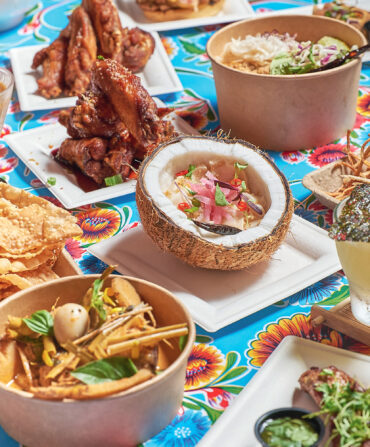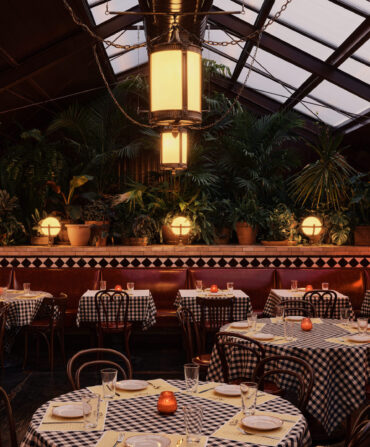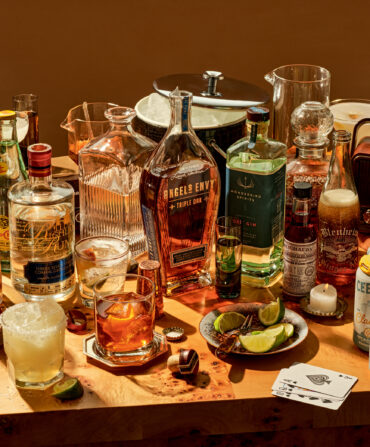Food & Drink
Meet the Gurus of Gravy
While lesser-known than gumbo or jambalaya, gravy is a Cajun classic worth its weight in gradoux. And at the annual Blackpot Cookoff in Lafayette, it’s the stuff of legend

Photo: CEDRIC ANGELES
Cast-iron vessels and tools of trade at the Blackpot Cookoff.
The Gravy Boys were born about ten years ago, when Tanner Dimmick and his friends were still in college. At first it was just the “Boys”: a bunch of dudes listening to music, playing poker, and getting hungry as the hour grew late. In other places, that might have meant ordering pizza or breaking into the cereal, but this was Lafayette, Louisiana, in the heart of Cajun Country. Thus, the “Gravy.”
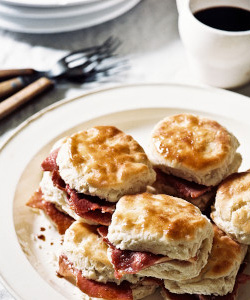
“Every house party you go to, there’s a simmering pot on the stove that’s been cooking for a mysterious amount of time,” says Dimmick, who is now thirty-two and runs the bar at Lafayette’s Spoonbill Watering Hole & Restaurant. “It’s just a communal thing. No one’s ever mad about food at one in the morning.” One thing led to another, and soon the Gravy Boys—with matching custom-made denim jackets—were hosting Gravy Thursdays, cooking for as many as eighty people every week. The goal was a good party, sure, but the ulterior motive was training for the Big Show, which in this case is the gravy competition at the Blackpot Festival and Cookoff.

Photo: Cedric Angeles
The Gravy Boys: Sullivan Zant, Tanner Dimmick, and Jacab Gibson.
And now, here we are, on a bright October Saturday morning, at the Vermilionville Living History and Folk Life Park, a campus of reproduced historical Cajun buildings hard by the Lafayette airport. On the baseball field set aside for camping across the way, festivalgoers are climbing out of their tents, groggy from a late Friday night of music and revelry around the campfire. But in the section of the parking lot reserved for the cook-off, a minivillage of cooking stations is already in full swing. It is a day whose progress you can follow by smell: The morning air is filled with the sharp aroma of raw onion, green pepper, garlic, and celery, wreathed with the warm perfume of cayenne and black pepper. We are in the time of the Chopping.
There are five categories at the Blackpot Cookoff, all of which, as the name suggests, must be cooked in a cast-iron vessel, preferably black: gumbo, jambalaya, cracklin’, dessert, and gravy. Of these, gravy might be the least known outside Acadiana and the most familiar inside it. By definition a gravy is made using the remnants and grease from seared meat. Beyond that, it’s sort of a you-know-it-when-you-see-it situation. Blackpot’s own official definition is notably vague: “Sauce…that good stuff they make on thursdays at the plate lunch place,” it reads.
Cajun cuisine is hardly the only one to make a virtue out of the necessity of stretching precious protein into a delicious sauce. But few if any take it more seriously. Cajun meals tend to be built backward: “Rice comes before everything,” says Joan Suire, who with her sister, Lisa Frederick, runs Suire’s Grocery and Restaurant in Kaplan, Louisiana, one of the area’s greatest gravy destinations. Next comes something to put on that rice—stews, fricassees, sauces piquantes, étouffées, gravies—and, only then, maybe a further protein. Hence, the delightful phenomenon, at Suire’s and elsewhere, of “side fish,” a piece of fried catfish that in most other dining contexts would be the main event.
Gumbo famously inspires passionate debate over nearly every part of its preparation. So does Cajun gravy, but somehow the battles seem less life-or-death. Gumbo is a little neurotic; gravy is chill. Gumbo is the guest for whom you have to clean the house two days in advance; gravy is the dude who’s happy to crash on your couch and may even do the dishes in the sink before you wake up.
And though gumbo may get all the fancy press, it’s gravy that’s king at Blackpot.
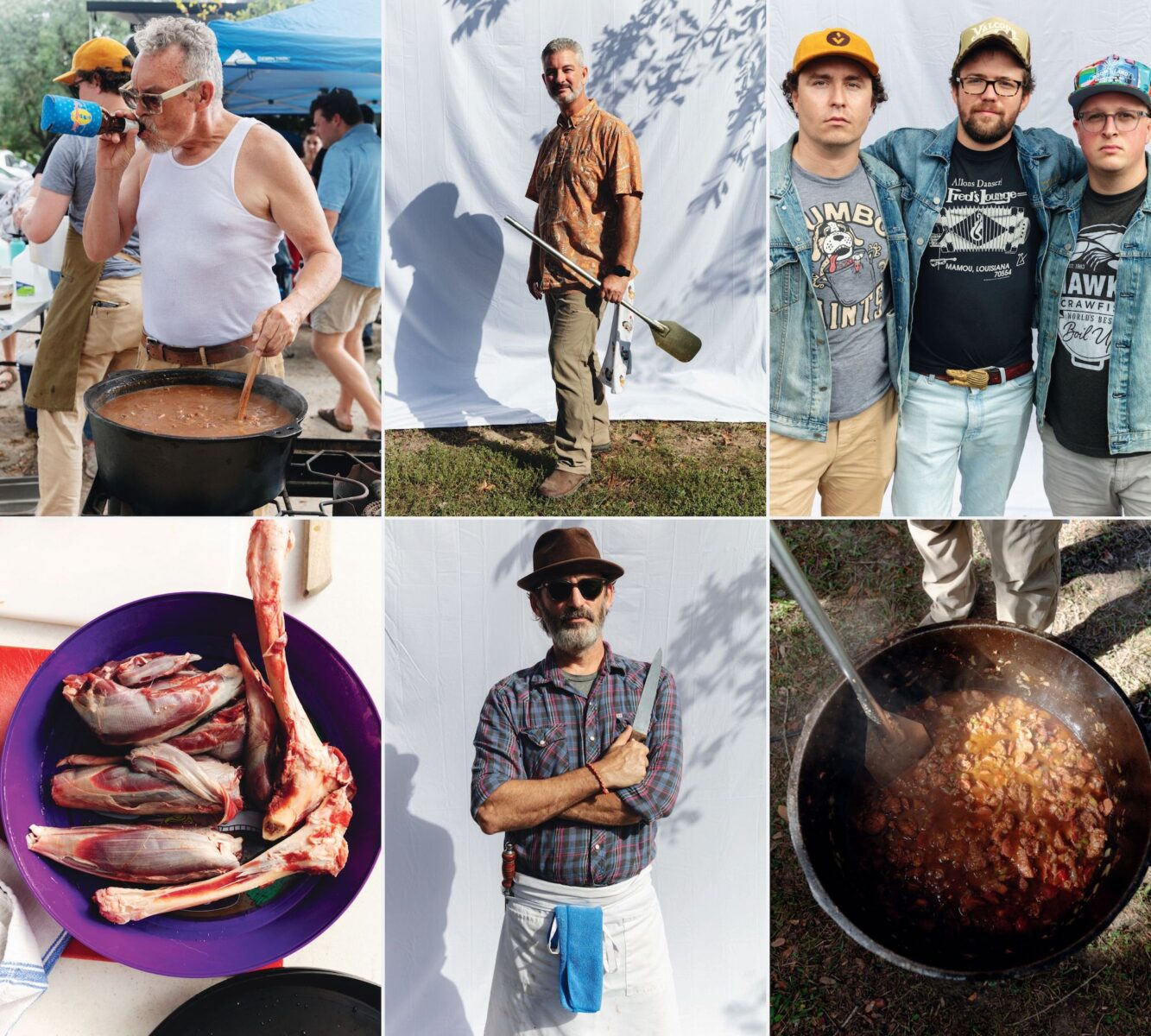
Photo: CEDRIC ANGELES
Cast-iron vessels and tools of trade at the Blackpot Cookoff.
“The gravy competition is sort of the Super Bowl,” says a civil engineer named Jared Arthur as he prepares the vegetables for his version, made with a pork shoulder blade. Arthur’s friend Jarald Earl is working on his own gravy, featuring doves he shot on a hunting trip the year before in Texas. They are part of a team called Rougarou Plus Two that has enjoyed past success here. “We’ve won jambalaya and gumbo, but never gravy, and it’s sort of eating at us,” Arthur says. “Everybody wants that gravy title.”
The smells now wafting across the parking lot indicate that the Browning has begun. Tanner Dimmick sears the hunk of pork back that will form the basis of his gravy while fellow Gravy Boy Jacab Gibson does the same with fat links of fresh deer sausage. (Their third partner, Sullivan Zant, is going off script by making a gumbo.) The goal for all of the teams is a healthy gradoux—the sticky browned bits, also called grismies, that form on the bottom of the pan and become the essential building blocks of gravy flavor. As required, the cooking vessels are all cast iron, but otherwise of wildly diverse body types. There are squat Dutch ovens and tall stockpots; skillets, braisers, woks, and even an Ooni outdoor pizza oven outfitted with a cast-iron skillet that one competitor, Steven Latiolais, uses to roast deer bones.

Photo: CEDRIC ANGELES
Though it's not officially required, participants are encouraged to prepare enough food to allow festival goers to get a taste.
Those bones belong to an eight-point buck that Latiolais shot in Mississippi the previous winter. Now he’s using the front and rear shanks to create gravy from what is essentially venison osso buco. Adam Batiste arrives and immediately sets to work on two different pots: One is crammed with oxtails and fresh deer sausage; the other holds a cut-up stewing hen. Batiste lives in New Orleans but grew up in nearby Carencro, from which his extended family has come to cheer him on. In the past, he says, he has made gravy with everything from turkey necks to beef tongue.
Unlike many of the cooks, Batiste usually likes to leave his meat in the pot when it comes time to brown his vegetables. “More magic happens when you brown all together,” he says. The whole competition could be a convocation on various philosophies of building flavor and texture. There are roux users and roux eschewers; fans of stock and those who claim anything but plain water is cheating; adders of tomato paste and gradoux purists; reducers, deglazers, and layerers. Some cook their vegetables down to such a dark, pudding-like consistency that at first glance it looks as though their black pots are empty.
Around this time, two more competitors arrive, hustling to catch up. Todd Rojas pulls an enormous beef chuck roast out of a cooler. He says it has been dry-brined and stuffed with habanero apricot pepper jelly and Gorgonzola. Geoff Thompson starts toasting a spice blend of coriander, bay leaf, allspice, and paprika, to be used for a dove breast gravy. The Chefs have arrived.
It’s an imaginative but risky strategy. “Sometimes these young guys, they like to play and dream up dishes,” says Madonna Broussard, who runs Laura’s II, a classic plate lunch destination in Lafayette justly celebrated for its rice and gravy. As a past Blackpot judge, Broussard says, “I have seen stuff that I would have never dreamed of putting up in my kitchen. I am happy to see it. But I like the mom-and-pop stuff.”
Jesse Guidry, a Lafayette native who works for the local tourism promotion office, learned this the hard way. He’s here as a spectator today but competed in the cook-off for many years. The first year he made gravy, he thought he would impress the judges by getting very cheffy. He made everything from scratch; pickled eggplant was involved. It was a disaster. “They’re not looking for creativity,” he says. “They’re looking for what your grandma made.”
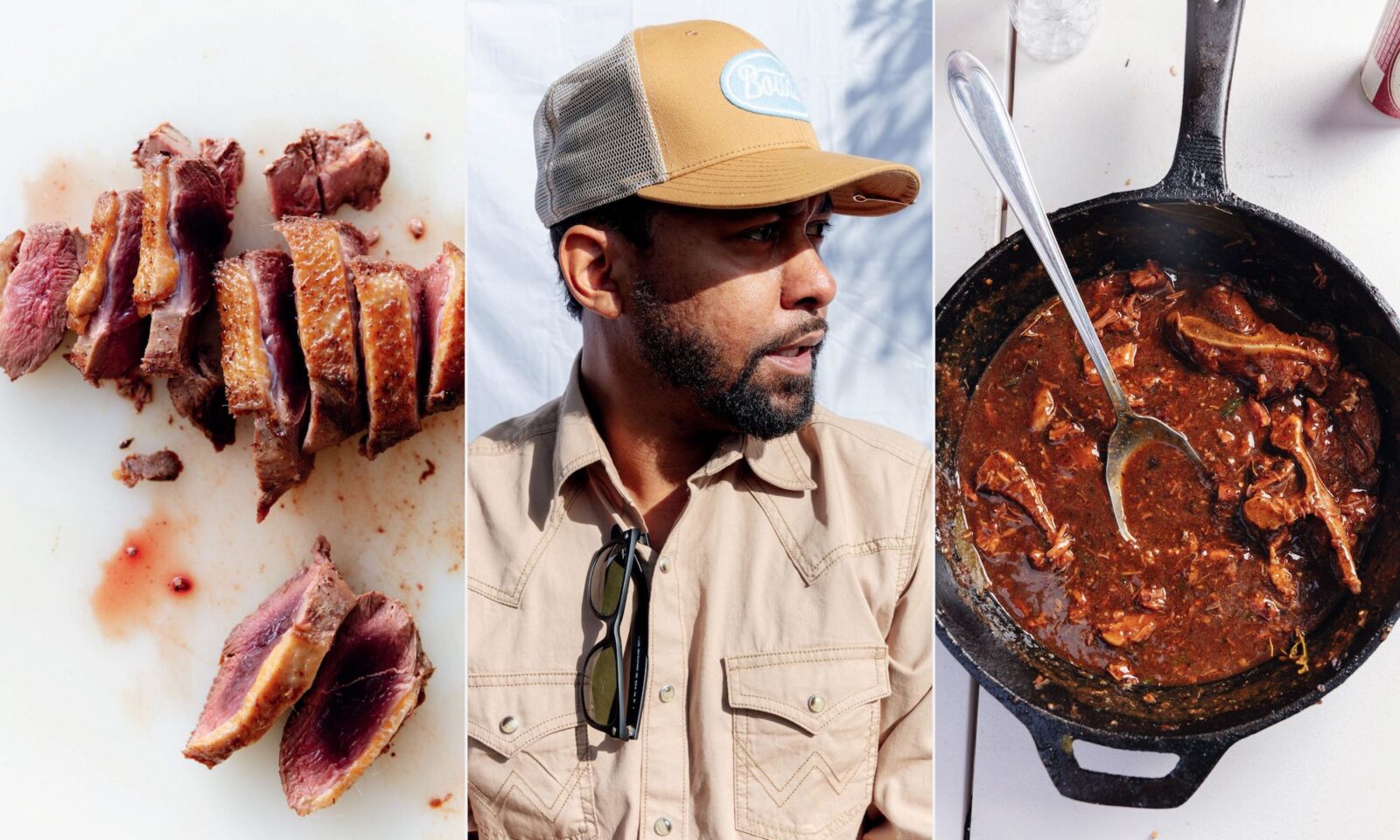
Photo: CEDRIC ANGELES
The Blackpot Festival & Cookoff began in 2006.
This brings us to an important irony of Cajun cuisine. While it is celebrated, even fetishized, as a rustic folk cuisine, it is also, in practice, eminently adaptable. Its practitioners—often matriarchs charged with feeding large numbers of mouths every day and on a budget—have always been among the quickest to adopt new techniques and technologies, whether that be the rice cooker, the microwave, or even (clutch your pearls!) premade roux.
So when Guidry returned to Blackpot the next year, he did so not with the arsenal of some sainted fantasy memaw, but of his actual Cajun grandma: cheap cuts of pork, cartons of Great Value vegetable stock, and, perhaps most shockingly, containers of prechopped vegetables from the supermarket. He claims the packages provided a certain tang that’s impossible to otherwise get. “It’s supercontroversial, but it wins,” he says. Indeed, in the years that followed, Guidry took first place in gravy and jambalaya, as well as in a Best of the Best competition for which he was awarded a wrestling-style champion’s belt.
We have reached the best part of the gravy cooking day. The sun is high; broth has been poured, pot lids placed, and flames set to low. It is time for the Thickening.
Or, put another way, it is time for the Drinking. The pop pop of beers opening mingles with the fiddle and accordion of a Cajun band that has started to play on a small nearby stage. At the Gravy Boys’ station, somebody has put out a spread of French pastries; a plate of boudin from the legendary Best Stop Supermarket, in Scott, Louisiana; and a brown paper bag, the spreading transparency of which betrays the warm chicken cracklings within. Toby Rodriguez, a local butcher who has gained fame for running traditional boucheries—communal gatherings centered on butchering and processing a hog—brings by a plate of chicken liver mousse. His Lache Pas Boucherie et Cuisine team has its own gravy bubbling a few spots over, made with chorizo and seven steak. A bottle of mezcal makes the rounds. This is the reward for all the frantic front-loaded labor that goes into a dish for which time, heat, and care will do the bulk of the work.
Still, danger lurks. Every gravy maker knows it, says Corey Porche, one of Blackpot’s organizers and the coordinator of the cook-off ’s judging. “Everything is going good. You turn away to talk to your friend for one second and then you go back to stir and…” He mimes hitting the bottom of a pot and finding a burned layer. He grimaces.
With that in mind, the competitors keep at least one eye sharp as the afternoon winds on. The gravies have begun to take on a sluggish tidal quality, not quite a jiggle, but a subtle heave, just thick enough to coat a spoon. “It shouldn’t run all over the plate,” Guidry says, “but it shouldn’t sit on top of the rice either.”
After an hour or two, Dimmick sneaks a taste of his gravy. He frets that it’s too spicy. “Yours is better than mine,” his friend Gibson says, a certain kind of buzzed male bonding having set in. “I think yours is perfect,” Dimmick tells him. They open another beer. Todd Rojas is doing something with an orange and a sweet potato.
Batiste’s oxtails have melted into a sticky brown mess, while his hen gravy, touched with tomato paste, has turned a deep brick red. He looks relaxed. “This isn’t a formalized way of cooking,” he says. “People forget that the end result is to eat.”
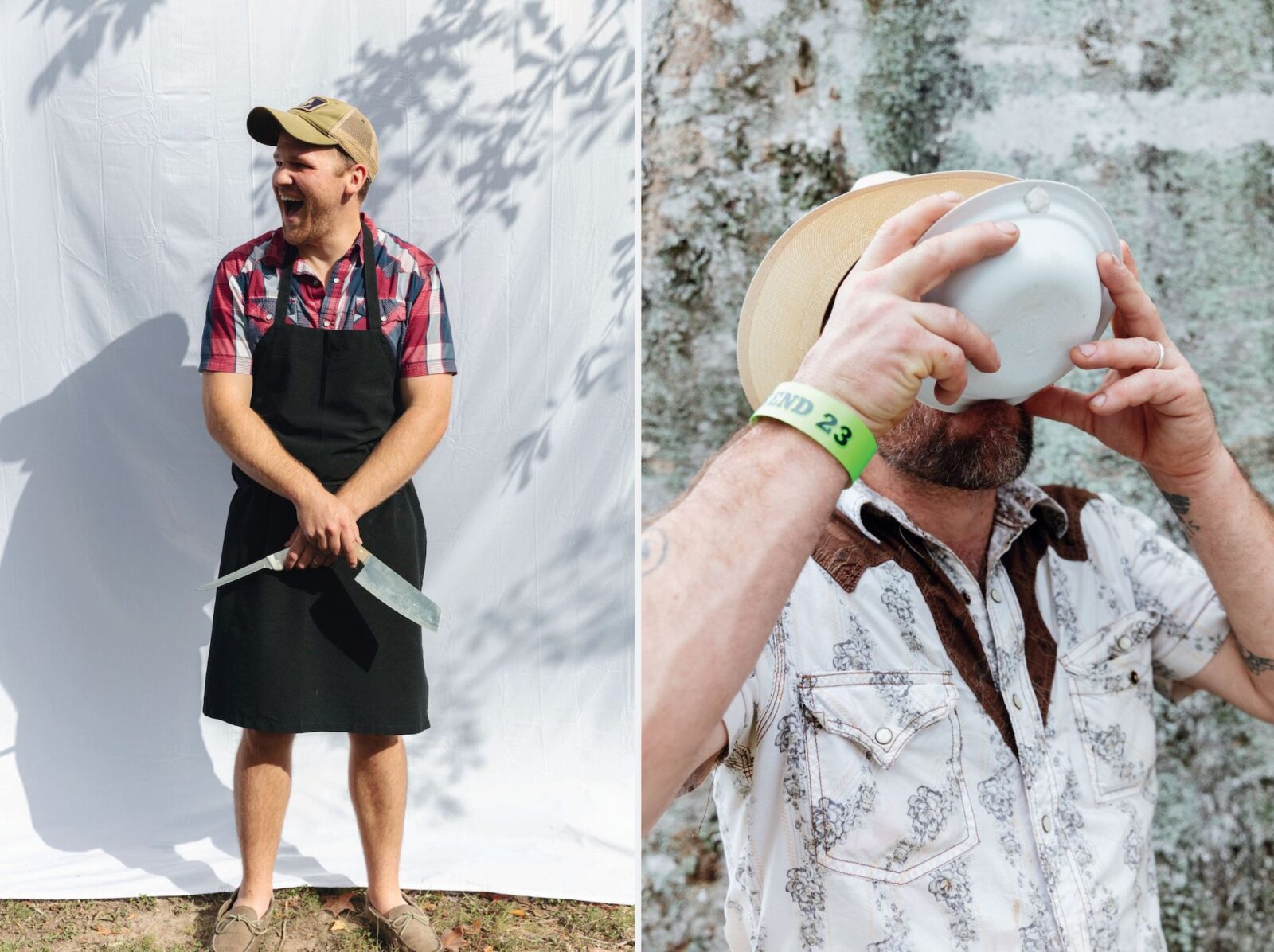
Photo: CEDRIC ANGELES
Competitors and visitors alike revel in sampling from teams' pots.
In point of fact, the evidence suggests that people have not forgotten this. A crowd of spectators has begun to form: hungry spectators, waiting for 3:00 p.m., when teams will begin giving out samples. They mass in front of each station, stamping their feet like anxious cattle.
“These people are kind of freaking me out,” says Dimmick, eyeing them nervously.
When the hour arrives, it’s a flat-out scrum. All hands are on deck, doling out rice and gravy until the tide recedes. Some canny competitors make a separate dish for public consumption or refuse to share at all, but the Gravy Boys nearly deplete their supply, leaving just enough for the judging, which is about to begin.
Wouldn’t it be nice to leave it here, with the sun going down, backs slapped, bellies full, and cooking flames extinguished? After all, what does competition have to do with the elemental pleasures of food? Must we ceaselessly rank those things that cannot be ranked?
Well, yes, I’m afraid we must. Like it or not, it is time for the Judging.
There are ten gravy entries in all. The competitors place a sample of their creations into a plastic takeout container, which is assigned a random number and then spirited away behind closed doors for a blind tasting by a panel of judges.
Of that tasting, perhaps the best thing that can be said is that it reflects a group of folks who have strong opinions, overfull stomachs, and a penchant for disappointment. In charge, in practice if not title, is a veteran judge named Kevin Huval, a member of a storied Cajun musical family. He is sitting in the center of the room and wearing a T-shirt reading Brooklyn in Varsity script. A few years ago, Huval began to feel that too many Américains were involved in judging Cajun foods in competitions like this and that, as a result, the process might have become less rigorous than he would prefer. He took it upon himself to recruit judges specifically from Acadian parishes.

Photo: CEDRIC ANGELES
The party gets into full swing with music and dancing.
“Which parish you from?” he yells at one judge, across the room. “Calcasieu?”
“Cameron Parish, baby!” he answers.
The conversation turns to the taxonomy of Cajun stews. Somebody mentions that some people use roux in their étouffée:
“Yes,” Huval acknowledges, pleasantly. “And they are wrong. And they should be shot.”
Unsurprisingly, he has his own particular standards for gravy. “I’m looking for a nice robust color—dark brown,” he says. “Not soupy, but not starchy. Just thick.” He prefers his vegetables still intact, cut rustically. Onions should be clear; peppers, well, they should just be “cooked right.” Given such specific parameters, it’s no great shock that none of today’s gravies hit all the criteria—even less so when Huval admits his real standard: “My grandmother had a meat market and restaurant,” he says. “When I taste a good gravy, I can taste her plate lunches.”
As somebody looking on whispers, with an air of hard-won wisdom: “Never, ever cook Cajun food for Cajuns.”

Photo: CEDRIC ANGELES
This year, the festival takes place on October 25 and 26.
For all that, there are nods of approval, murmurs of appreciation, even smacking of lips as the judges taste gravies one by one. The entries receive a score ranking them, as the official judging guide puts it, from “Lawd Day to Bruh, I’m gonna have to slap your grandmomma and them.” Inside at the main festival stage, the cooks begin to congregate. It’s the weekend before Halloween, and the crowd is dotted with costumes: alligators, the stray crawfish, several Tabasco bottles. Rojas has donned a clown’s hat and ruffle.
“It’s never about winning,” says Dimmick as the Gravy Boys gather. “But winning would be damned cool.”
Today he will have to settle for third place—which to judge by the generalized Gravy Boy whooping is damned cool enough. Second place goes to Lache Pas Boucherie’s seven steak and chorizo gravy. And it’s Adam Batiste, who submitted his oxtail gravy for judging, who takes first. He is borne aloft and carried around the room like a king.
Then he collects the prize for his long day’s labor and all the care, knowledge, creativity, and tradition that went into it: $125 and a new cast-iron pot, in which to keep the good stuff bubbling until it’s time to start it all again next year.


